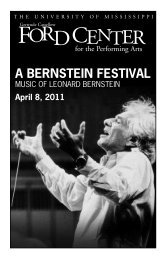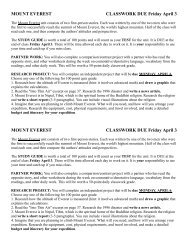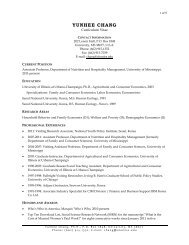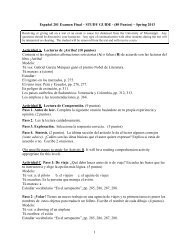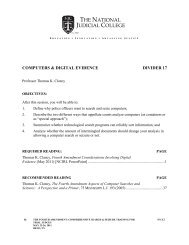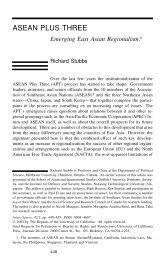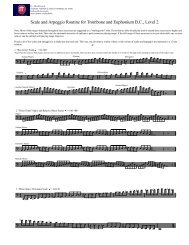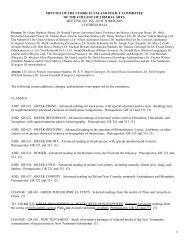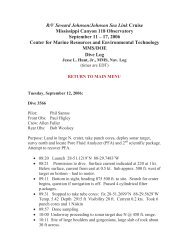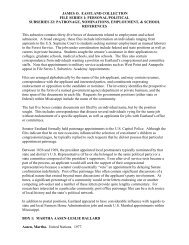Tournament Rules and Conditions (PDF)
Tournament Rules and Conditions (PDF)
Tournament Rules and Conditions (PDF)
Create successful ePaper yourself
Turn your PDF publications into a flip-book with our unique Google optimized e-Paper software.
OLEMISS CRICKET TOURNAMENT<br />
(TAPE TENNIS BALL)<br />
RULES AND PLAYING CONDITIONS<br />
MAY 2009<br />
www.olemiss.edu/orgs/omcc/
SECTION 1: GENERAL<br />
1.0 The competition shall be known as the Olemiss Cricket <strong>Tournament</strong><br />
[hereafter referred to as the OCT competition]. The Executive Committee of the<br />
OCT shall be responsible for the administration of the competition <strong>and</strong> shall have<br />
jurisdiction for the implementation <strong>and</strong> interpretation of the rules <strong>and</strong> playing<br />
conditions governing the competition.<br />
1.1 Except for those laws that are unique to local playing situations <strong>and</strong><br />
conditions, the Olemiss Cricket <strong>Tournament</strong>, OCT, will abide by the latest<br />
available ICC st<strong>and</strong>ard playing conditions, <strong>and</strong> the associated Laws of Cricket<br />
document [Code]. The complete <strong>and</strong> latest ICC code can be found, at ICC’s<br />
website. In the event of conflicts, the rules as stipulated by the OCT shall<br />
supersede.<br />
1.2 Only OCT approved balls shall be used in the Competition. Each team will be<br />
provided with one approved ball from the officials prior to the start of the<br />
tournament.<br />
1.3 In case of inclement weather or other unforeseen circumstances during the<br />
competition, the Executive Committee has the authority to enforce the<br />
rescheduling of the game.<br />
1.4 Participating teams have to fill a form <strong>and</strong> submit 100$ towards participation.<br />
Captain <strong>and</strong> Entire team will also have to sign <strong>and</strong> submit a Waiver. The OCT<br />
participation fees take care of the Balls, trophies <strong>and</strong> other arrangements during<br />
the tournament. The <strong>Tournament</strong> kicks off at the end of third week of May(Dates<br />
will be Announced)<br />
SECTION 2: FORMAT<br />
2.1 The Olemiss Cricket <strong>Tournament</strong> will be run as follows<br />
2.2 All games leading up to the finals shall be limited to a maximum of fourteen<br />
(14) over’s per inning.<br />
2.3 The Final shall be limited to 16 over’s per inning.<br />
2.4 No Power play restrictions in the tournament<br />
2.5 FORMAT—will be announced later
SECTION 3: THE PITCH<br />
3.1 Area of pitch: All OCT games will use a pitch that measures 22 yards or<br />
20.12 meters in length.<br />
3.2 Wide markers: Markers that will be used for the calling of wide balls shall be<br />
placed at one bat length from the middle stump.<br />
SECTION 4: STANDINGS, REPORTS AND POINTS<br />
4.1 Scoring is made by OCT official <strong>and</strong> it is also encourage each team to submit<br />
their score sheet at the end of each games<br />
4.2 Tie breaker rules: At the end of the each game, if two teams are tied then<br />
we apply the TIE BREAK rules as follow<br />
The team with higher net run rate will be declared as winner<br />
The calculation will use the following formulae:<br />
a. Net Run Rate (NRR) = (Runs scored / Overs Played) – (Runs<br />
conceded / Overs Bowled). This is formula being used currently<br />
EXAMPLE: [Team “A” scored 678 runs in 147.3 overs, for a run rate of 4.602.<br />
Team opposing “A” has scored 466 runs in 150 overs, a run rate of 3.107.<br />
Therefore the Net Run Rate (NRR) is; 4.602 minus 3.107, or 1.495]<br />
The rounding of decimal will be to third decimal as shown above.<br />
Note: In the event of a team being all out in less than its full quota of overs, the<br />
calculation of its net run rate shall be based on the full quota of overs to which it<br />
would have been entitled <strong>and</strong> not on the number of overs in which the team was<br />
dismissed.<br />
SECTION 5: OVERS<br />
5.1 All matches in the first round shall be limited to (1) one inning of (14) fourteen<br />
over’s maximum per side. And final will be (16) sixteen over’s maximum per side<br />
5.2 Each bowler shall be allowed a maximum of (4) four overs in the first round.<br />
SECTION 6: VENUE FOR MATCHES
Intramural fields, olemiss, oxford, MS<br />
SECTION 7: USE OF PROTECTIVE EQUIPMENT<br />
The OCT firmly believes in the safety of its participants <strong>and</strong> encourages the use<br />
of protective equipment as each player sees fit, but within the following rules.<br />
7.1 Protective equipment is any visible item of apparel worn for protection<br />
against external blows.<br />
7.2 For a batsman, items permitted are a helmet, external leg guards (batting<br />
pads), <strong>and</strong> batting gloves.<br />
7.3 For a fielder, only a helmet is permitted, except in the case of a<br />
wicketkeeper, for whom wicket-keeping pads <strong>and</strong> gloves are also permitted. A<br />
wicket-keeper may substitute batting pads for wicket-keeping pads.<br />
7.4. The wicket-keeper is the only member of the fielding side permitted to<br />
wear gloves <strong>and</strong> external leg guards.<br />
7.5 The gloves used by a wicket-keeper shall ONLY be those that are<br />
permitted under the ICC rules.<br />
7.6 H<strong>and</strong> warmers, oven mitts, baseball mitts <strong>and</strong> such other h<strong>and</strong> coverings<br />
are NOT to be substituted as wicket-keeping gloves <strong>and</strong> are not deemed<br />
acceptable as protective gear for a wicket-keeper in the field of play.<br />
SECTION 8: DELAYED OR INTERRUPTED MATCHES<br />
8.1 In the event a game is curtailed by rain, bad light, or any other weather<br />
related factors, the following rules shall apply:<br />
8.2 The match can be postponed only if :<br />
a) It is completely rained out<br />
b) If it is rendered unplayable by overnight rains etc. (Neutral umpires will<br />
decide after evaluating the ground conditions)<br />
c) If it is interrupted by unforeseen factors like eviction etc.<br />
8.3 There shall be no winner unless a minimum of (10) ten overs is completed in<br />
the second inning. Otherwise, this constitutes an incomplete game <strong>and</strong> the entire<br />
game will be rescheduled.
8.4 If more than 10 overs have been bowled in the second inning, <strong>and</strong> play<br />
stopped on account of weather, the game will be continued from the point of<br />
stoppage of play <strong>and</strong> completed as early as a reschedule is possible. Every<br />
effort should be made to complete the game on the same ground where the first<br />
innings was played.<br />
SECTION 9: STATUS OF GROUNDS<br />
9. 1 The OCT guarantee that every match will have a complete (360 degree)<br />
field of play.<br />
9. 2 Each team WILL play on the ground that is assigned to them. Period. No<br />
questions. End of discussion.<br />
9. 3 Declining to play for reasons such as “we don’t like this ground”, “we have a<br />
better ground…lets go <strong>and</strong> play there”, “we like playing on baseball grounds”<br />
etc., will constitute an automatic forfeiture of the game. Period. No questions.<br />
End of discussion.<br />
SECTION 10: RESTRICTIONS ON THE PLACEMENT OF FIELDSMEN<br />
10.1 There will be no more than 5 players on the leg side at any point of time<br />
10.2 Captains or their designee must exchange lineups prior to spinning the<br />
toss. The toss must be spun no later than 15 minutes prior to the scheduled start<br />
of the game. At the scheduled start time both teams must be present on the<br />
playing field with at least 8 players at which time the st<strong>and</strong>ing umpire will call<br />
play.<br />
10.3 If after 45 minutes from the scheduled start time one of the teams is not<br />
present on the field with at least 8 players, the game shall be canceled <strong>and</strong><br />
points shall be awarded to the team that was ready for play.<br />
10.4 Wicket keeper <strong>and</strong> fielding movements: Neither of them can move<br />
significantly (NOT more than 2 steps) after the batsman has taken his stance,<br />
which is considered to be a distraction. The fielder is not allowed to move<br />
significantly (a deep square leg cannot become a square leg). Same holds good<br />
sideways (a deep square leg cannot become a deep mid-wicket). And a wicketkeeper<br />
cannot come close to the stump if he is at a significant distance from the<br />
stumps, after the batsman has taken his stance <strong>and</strong> before the ball passes the<br />
batsman. Only a slightest of movement is allowed. If any of these are not met the<br />
Umpire could call it to be a DEAD BALL (not a NO BALL) on his own or on upon<br />
an objection raised by the players of the opponent team.
SECTION 11:INSURANCE<br />
11.1 The OCT is not responsible for accidents or injuries that a player may suffer<br />
while traveling to/fro the grounds, while playing, or even simply spectating a<br />
game.<br />
11. 2 The OCT or members of the Executive Committee will not be held liable for<br />
any accidents or injuries that a player may suffer while traveling to/fro the<br />
grounds, while playing, or even simply spectating a game.<br />
11. 3 All the teams should sign the registration & waiver form before the first<br />
game of the season. This waiver absolves the OCT <strong>and</strong> its management of any<br />
liability from injuries caused to players from participating or watching the OCT<br />
games.<br />
11. 4 It’s simple…if you get hurt (which we hope never happens), you are on<br />
your own.<br />
SECTION 12:UMPIRING<br />
12.1 Appointment of umpires<br />
The neutral umpires shall be appointed before the match, to conduct <strong>and</strong> control<br />
the game as required by the Laws, with absolute impartiality. The umpires shall<br />
be present on the ground at least 15 minutes before the commencement of the<br />
play.<br />
12.2 UMPIRES DECISIONS ARE FINAL. Even if you do not like or agree with<br />
the decision of the umpires, you accept it <strong>and</strong> move on. No cursing, no<br />
screaming, no calling names (in any language), no filing protests, nothing that<br />
violates the spirit of the game. Period. No questions. End of discussion.<br />
12.3 Fair <strong>and</strong> unfair play<br />
The umpires shall be the sole judges of fair <strong>and</strong> unfair play on the field.<br />
1. Umpires shall impose penalties on any player who does not comply with<br />
st<strong>and</strong>ards of the game as he deems fit.<br />
2. Umpires shall report such occurrences to the Executive Committee<br />
SECTION 13: RESPONSIBILITIES<br />
13.1 It is the responsibility of BOTH captains to see that decorum is maintained<br />
at all times <strong>and</strong> the spirit of the game is adhered to.
SECTION 14: DISPUTES<br />
14.1 Disputed games shall be arbitrated by the executive committee OCT along<br />
with representatives of both teams <strong>and</strong> the officiating umpires.<br />
SECTION 15: LEG BEFORE WICKET (LBW)<br />
This one is easy! We do not consider lbws in our games. So, a batsman should<br />
not be ruled out on account of lbw.<br />
SECTION 16: LEG BYES<br />
This is easy too! We do not consider leg byes. No runs score on leg byes. The<br />
ball is simply ruled dead. So there are no run outs on those balls too.<br />
SECTION 17: WIDE BALL<br />
17.1 Use a cone or a flag as a marker to call wides (measured as one bat from<br />
the middle stump). A ball is a wide if it passes so high or wide that it is beyond<br />
the reach of the striker. The ball must pass behind the batsman AND outside the<br />
leg stump to be ruled a wide down the leg side. For wides outside the off stump<br />
the ball pass outside the cone or flag marker. If you are going to call a ball on the<br />
off-side that goes over the cone/flag as a wide ball, then simply consistently call it<br />
as such throughout the game.<br />
17.2 The umpire shall not call “wide” if the batsmen moves to a position so that<br />
the ball is beyond his reach or moves to a position so that the ball is within his<br />
reach. A wide does not count in an over.<br />
17.3 The striker may be out five ways off a wide: Run out, stumped, hit wicket,<br />
h<strong>and</strong>led the ball <strong>and</strong> obstructing the field. The umpire should call <strong>and</strong> signal<br />
“wide” as soon as the ball passes the stumps. All runs scored off a wide are<br />
recorded as wides, not byes. Obviously if the ball touches the striker’s person a<br />
wide would not be called. One run is given to a wide ball that has no other runs<br />
scored off it.<br />
SECTION 18: BYE<br />
A bye is called when a legal delivery passes the stumps without the ball touching<br />
either the bat or the batsman's body.<br />
SECTION 19: NO BALL
19.1 Mode of delivery<br />
(a) The umpire shall ascertain whether the bowler intends to bowl right h<strong>and</strong>ed or<br />
left h<strong>and</strong>ed, over or round the wicket, <strong>and</strong> shall so inform the striker. It is unfair if<br />
the bowler fails to notify the umpire of a change in his mode of delivery. In this<br />
case the umpire shall call <strong>and</strong> signal No ball.<br />
(b) Underarm bowling shall not be permitted<br />
(c ) Fair delivery - the feet<br />
For a delivery to be fair in respect of the feet, in the delivery stride the bowler's<br />
front foot must l<strong>and</strong> with some part of the foot, whether grounded or raised,<br />
behind the popping crease. A simple rule of thumb would be…..If umpire can see<br />
the popping crease behind the bowler's front foot (toe, heel <strong>and</strong> all!), then it is NO<br />
BALL.<br />
19.2 We do not enforce the return crease rules for no balls.<br />
19.3 One run will be awarded for a No ball.<br />
19.4 We don’t have a Free-Hit rule<br />
SECTION 20: DEAD BALL<br />
A dead ball is either if the ball pitches more than ONCE or rolls before it reaches<br />
the batsman.<br />
SECTION 21: HEIGHT<br />
21.1 If in the judgment of the bowler’s end umpire the ball has passed or would<br />
have passed over the batsman’s shoulder if he were in his normal batting stance,<br />
the bowler’s end umpire shall call <strong>and</strong> signal a No ball.<br />
21.2 NO ball calls on height shall be made only by the bowler’s end umpire.<br />
The bowler’s end umpire may consult with his colleague if he feels the need to do<br />
so.<br />
21.3 Full tosses above the waist<br />
If in the judgment of the bowler’s end umpire the ball has passed or would have<br />
passed over the batsman’s waist if he were in his normal batting stance without<br />
touching the ground, the bowler’s end<br />
umpire shall call <strong>and</strong> signal a No ball.<br />
SECTION 22: RUN OUT BY “MANKEDED”
22.1 When the batsman at the non-striker’s end has backed up out of his<br />
crease <strong>and</strong> the bowler in his run-up (but before having entered his delivery stride)<br />
removes the bails with the batsman out of his crease, the batsman is said to<br />
have been "Mankaded". Technically, the dismissal falls under the run-out<br />
category.<br />
22.2 A bowler cannot run out a non-striker once he has entered his delivery<br />
stride. The delivery stride is defined as the stride in the course of which the<br />
delivery swing is made: it starts when the bowler's back foot l<strong>and</strong>s <strong>and</strong> ends<br />
when the front foot l<strong>and</strong>s in the same stride." A bowler has to warn the batsman<br />
at least once before running him out in this way.<br />
22.3 In simple terms, a bowler cannot run-out the non-striker once he has started<br />
to swing his arm to bowl. From the non-strikers perspective stay within the<br />
crease until the bowler starts his swing.<br />
22.4 The umpires’ decision shall be final as to the fairness of the delivery<br />
SECTION 23:UNIFORMS<br />
The OCT does NOT m<strong>and</strong>ate uniforms for participating teams. Although we<br />
think they look pretty cool!<br />
SECTION 24: AWARD TROPHIES<br />
OCT will present winner trophies at the end of the Final. This will be held at the<br />
venue where the Finals for the OCT will be played.<br />
Post match the following felicitations will be done:<br />
1. Trophy to the winning Captain/Team.<br />
2. Trophy for the losing team.<br />
All the prizes will be decided by the Executive Committee.<br />
Family <strong>and</strong> Friends come to watch <strong>and</strong> cheer the finalists. Snacks are served<br />
<strong>and</strong> photo sessions are held. It is a festive atmosphere where we expect most of<br />
the OCT members to join in to enjoy a good game of cricket



